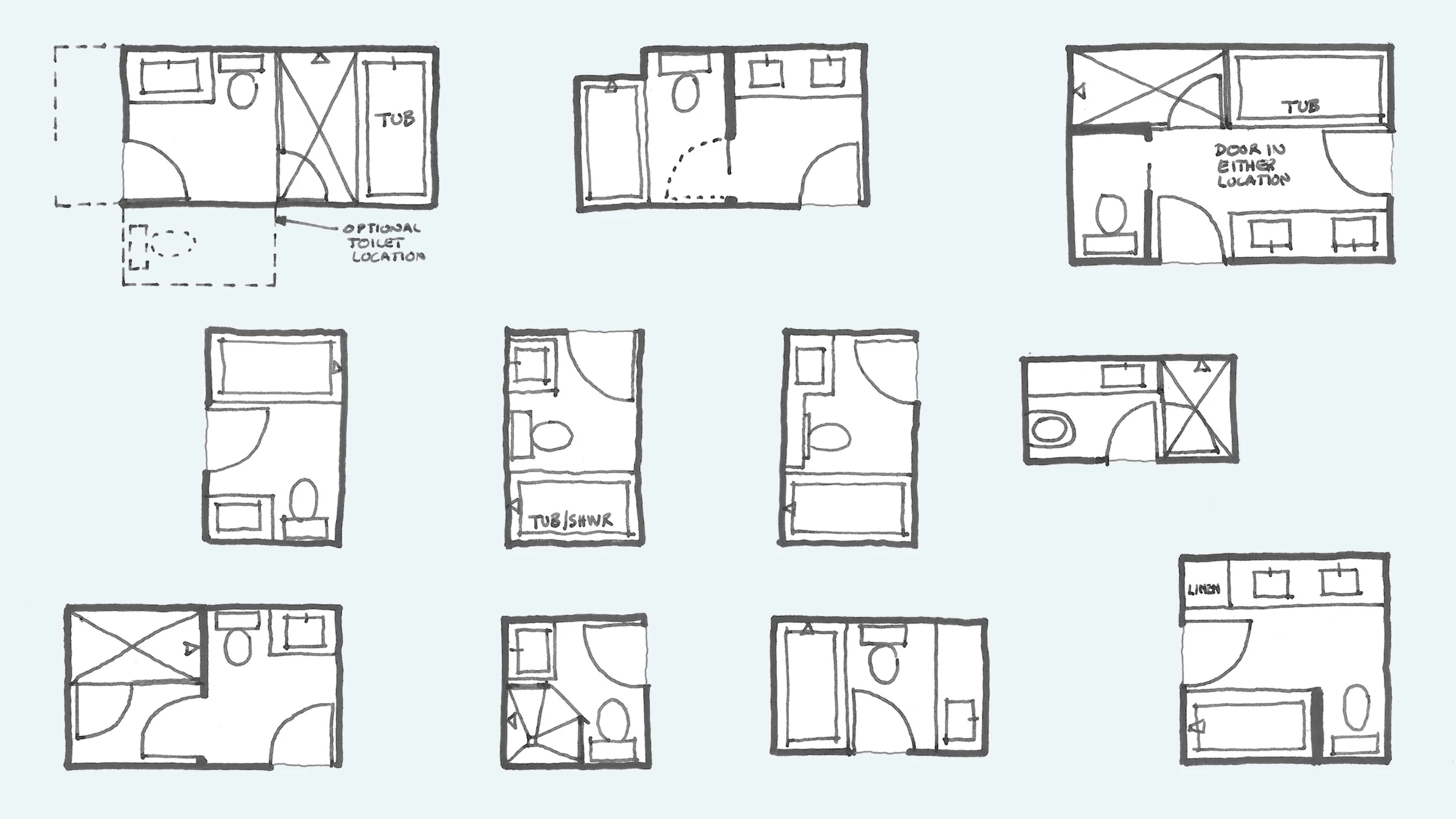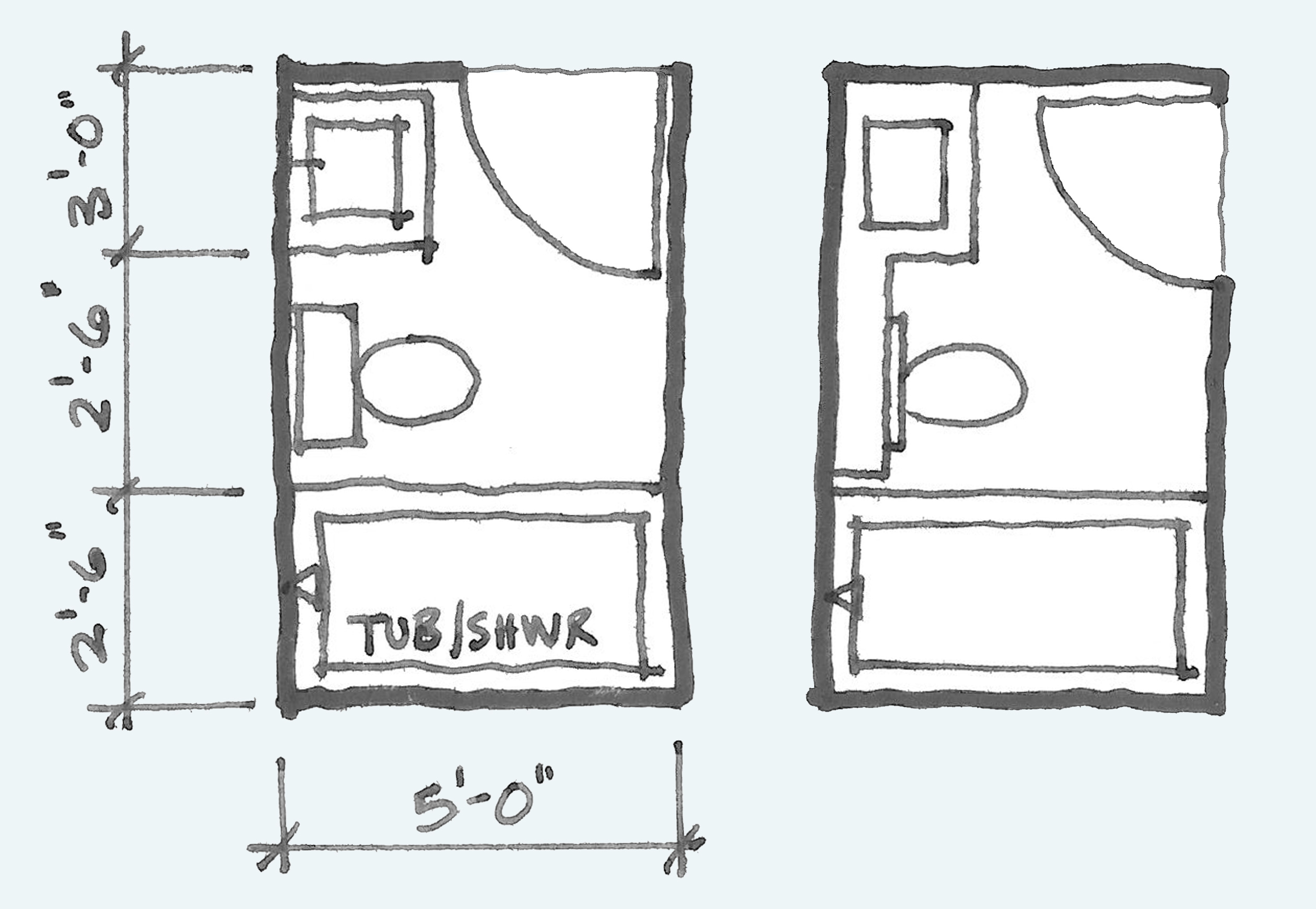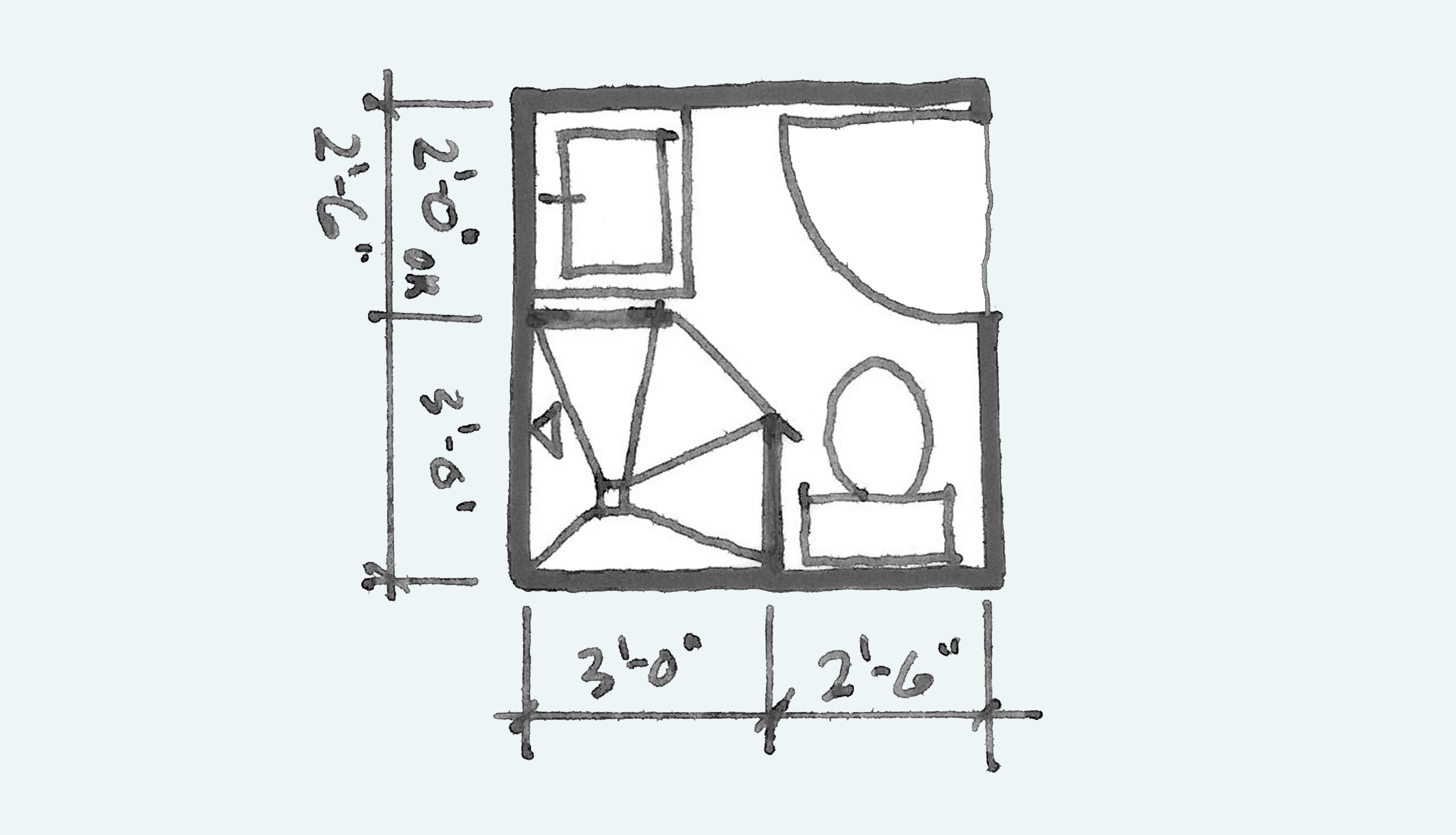Understanding Tiny 3/4 Bathroom Floor Plans

Tiny bathrooms, often found in smaller homes or apartments, present unique design challenges. These spaces require clever solutions to maximize functionality while maintaining a sense of comfort and style.
Common Design Challenges
Creating functional tiny bathroom floor plans requires careful consideration of limited space and the need to accommodate essential fixtures. Here are some common design challenges:
- Limited Space: Tiny bathrooms offer minimal square footage, making it crucial to utilize every inch effectively.
- Fixture Placement: Positioning the toilet, sink, and shower within a confined area requires strategic planning to ensure comfortable and efficient use.
- Storage Solutions: Finding adequate storage for toiletries and towels in a tiny bathroom is a constant challenge.
- Ventilation and Lighting: Ensuring proper ventilation and sufficient lighting in a small space can be difficult, but is essential for a comfortable and functional bathroom.
Space-Saving Techniques
Innovative space-saving techniques are essential for maximizing functionality in tiny bathrooms. Here are some examples:
- Corner Showers: Corner showers utilize space efficiently by fitting into a corner, maximizing floor space for other fixtures or storage.
- Wall-Mounted Toilets: Wall-mounted toilets save floor space by eliminating the need for a bulky base. This creates a more open and spacious feel.
- Floating Vanities: Floating vanities provide a sleek and modern look while maximizing floor space. They also offer easy access to plumbing and electrical connections.
- Vertical Storage: Utilizing vertical space with tall cabinets, shelves, and mirrors maximizes storage capacity while minimizing floor space usage.
- Multi-Functional Fixtures: Combining a shower and bathtub or a sink and vanity can save space while providing multiple functionalities.
Essential Elements
A well-designed tiny bathroom floor plan should include these essential elements:
- Toilet: A comfortable and functional toilet is essential. Consider a compact model or a wall-mounted option to save space.
- Sink: A compact sink with adequate counter space is crucial for daily routines. Floating vanities or corner sinks can maximize space.
- Shower: A shower stall is typically preferred in tiny bathrooms due to its space-saving design. Corner showers or walk-in showers are popular options.
- Storage: Adequate storage is essential for toiletries, towels, and other bathroom necessities. Utilize vertical space with shelves, cabinets, or a mirrored medicine cabinet.
- Lighting: Proper lighting is crucial for visibility and functionality. Consider installing a combination of overhead lighting and task lighting for specific areas.
- Ventilation: A well-ventilated bathroom prevents moisture buildup and ensures a fresh and comfortable environment. Install an exhaust fan or consider a window for natural ventilation.
Layout Comparisons
Different layouts offer advantages and disadvantages, depending on the specific requirements and preferences of the homeowner. Here’s a table comparing the pros and cons of some common tiny bathroom layouts:
| Layout | Pros | Cons |
|---|---|---|
| Single Vanity | Simple and efficient, maximizes floor space. | Limited counter space, may not be suitable for multiple users. |
| Corner Shower | Saves floor space, allows for more room for other fixtures. | May feel cramped, requires careful planning for water drainage. |
| Wall-Mounted Toilet | Creates a more open and spacious feel, saves floor space. | May require specialized plumbing, can be more expensive. |
| Floating Vanity | Modern and sleek, maximizes floor space, easy access to plumbing. | Can be more expensive, may not be suitable for all styles. |
Designing for Functionality

Designing a tiny bathroom floor plan is a balancing act between maximizing space and ensuring functionality. The goal is to create a comfortable and efficient space that meets your daily needs without feeling cramped.
Sample Tiny Bathroom Floor Plan
A well-designed tiny bathroom can be surprisingly spacious. Here’s a sample floor plan that incorporates a shower stall, toilet, and vanity:
- Shower Stall: Place the shower stall in a corner to maximize space. Consider a compact, walk-in shower with a glass door for a visually open feel. A corner shower stall provides a practical solution for smaller bathrooms, as it takes up less space than a standard shower enclosure.
- Toilet: Position the toilet adjacent to the shower stall, optimizing plumbing connections and creating a distinct wet area. A space-saving wall-mounted toilet can free up floor space and create a more airy feel.
- Vanity: A floating vanity with a small sink can be placed opposite the toilet, offering ample counter space and storage. A narrow, rectangular mirror above the vanity can create an illusion of more space.
Optimizing Flow and Accessibility
A key element of a functional tiny bathroom is maximizing flow. Here’s how to achieve this:
- Clear Pathways: Ensure ample space for movement around the toilet, shower, and vanity. Maintain a minimum of 30 inches of clear pathway around each fixture to allow for easy movement.
- Accessible Features: Consider accessibility features such as grab bars, non-slip flooring, and a raised toilet seat. These features can be incorporated without compromising on style and can make the bathroom more comfortable and user-friendly.
Compact Storage Solutions
Maximizing storage in a tiny bathroom is crucial. Here are some ideas for compact storage solutions:
- Shelves: Utilize wall space with open shelving to store towels, toiletries, and other essentials. Consider using floating shelves or corner shelves to optimize space.
- Cabinets: A floating vanity with built-in cabinets provides ample storage space for toiletries, medications, and other bathroom necessities. A small medicine cabinet above the sink can be used for storing frequently used items.
- Built-in Storage: Incorporate built-in storage solutions such as a niche above the toilet for storing towels or a recessed shelf in the shower stall for shampoo and soap. These solutions can create a seamless look and provide additional storage space.
Steps for Designing a Functional and Aesthetically Pleasing Tiny Bathroom
Creating a functional and aesthetically pleasing tiny bathroom requires careful planning and attention to detail. Here’s a step-by-step guide:
- Measure the Space: Begin by accurately measuring the space available for the bathroom. This will help you determine the maximum size of fixtures and furniture.
- Choose a Layout: Consider different layout options for the shower, toilet, and vanity. Experiment with different configurations to find the most efficient and comfortable layout for your needs.
- Select Fixtures: Choose compact and space-saving fixtures, such as a wall-mounted toilet, a corner shower stall, and a small vanity.
- Plan Storage: Incorporate storage solutions that maximize space and keep the bathroom organized. Consider shelves, cabinets, or built-in storage options.
- Choose Colors and Materials: Select light and airy colors and reflective surfaces to create an illusion of more space. Use water-resistant materials that are easy to clean.
- Add Finishing Touches: Incorporate decorative elements such as mirrors, artwork, and plants to add personality and create a welcoming atmosphere.
Inspiration and Ideas: Tiny 3 4 Bathroom Floor Plans

Creating a tiny bathroom that’s both functional and aesthetically pleasing is a challenge, but it’s definitely achievable. By incorporating smart design choices and focusing on key elements, you can transform your small space into a sanctuary.
Visual Appeal and Functionality
The key to designing a visually appealing tiny bathroom lies in the balance between functionality and aesthetics. You can achieve this by prioritizing essential elements while incorporating design features that enhance the space’s visual appeal.
- A well-designed shower enclosure with a glass door or a shower curtain that blends seamlessly with the overall colour scheme can create a sense of spaciousness and enhance the visual appeal.
- Mirrors strategically placed on walls can visually expand the space and reflect light, making the bathroom feel larger and brighter.
- A compact vanity with a floating design or a pedestal sink can maximize floor space and create a streamlined look.
- Consider incorporating a floating shelf or a wall-mounted storage unit to maximize vertical space and keep toiletries organized.
- A sleek, minimalist toilet design with a wall-mounted configuration can enhance the overall visual appeal and save floor space.
Creating a Sense of Spaciousness
The perception of space in a tiny bathroom can be significantly influenced by design choices. Implementing strategic design elements can make the bathroom feel more spacious and welcoming.
- Using light colours on walls and ceilings can create a sense of spaciousness and make the bathroom feel brighter and more inviting. Opt for white, cream, or pale shades of blue or green to visually enlarge the space.
- Incorporating large, framed mirrors can reflect light and visually expand the space, making it appear larger and brighter. Position the mirrors strategically to maximize their effect.
- Minimalist decor and furnishings can create a sense of openness and reduce clutter, contributing to a more spacious feel. Avoid excessive accessories and decorations that might make the space feel cramped.
- Choosing sleek and streamlined fixtures and fittings can minimize visual clutter and enhance the overall aesthetic appeal. Opt for minimalist designs and avoid bulky or overly ornate fixtures.
- Maximizing natural light by installing a large window or a skylight can significantly enhance the perception of space and create a brighter and more welcoming atmosphere.
Color Palettes and Lighting
The choice of colour palette and lighting can dramatically impact the perceived size of a small bathroom. Strategic use of these elements can make the space feel larger and more inviting.
- Using light and neutral colours on walls and ceilings can visually expand the space and create a sense of openness. Consider using white, cream, or pale shades of blue or green to enhance the sense of spaciousness.
- Incorporating contrasting colours or accents can add visual interest and depth to the space without making it feel cluttered. Use bold colours sparingly, such as on a single wall or in accessories.
- Using bright and warm lighting can create a welcoming atmosphere and enhance the overall aesthetic appeal of the bathroom. Consider using recessed lighting or pendant lights to provide even illumination.
- Adding a decorative mirror with a warm light bulb can enhance the reflection of light and create a more inviting and luxurious feel. Opt for a mirror with a subtle backlighting feature.
- Using a combination of natural and artificial light can create a balanced and inviting atmosphere. Maximize natural light by installing a window or a skylight and supplement with strategically placed artificial light sources.
Natural Materials and Textures, Tiny 3 4 bathroom floor plans
Incorporating natural materials and textures can bring a sense of warmth, sophistication, and tranquility to a tiny bathroom.
- Using natural stone, such as marble or granite, for countertops and flooring can add a touch of elegance and sophistication to the space. These materials are durable and easy to maintain, making them ideal for a small bathroom.
- Incorporating wood elements, such as a wooden vanity or a bamboo shelf, can add warmth and texture to the bathroom. Choose wood finishes that complement the overall colour scheme and style of the space.
- Using natural fiber rugs, such as jute or sisal, can add warmth and texture to the floor while providing a soft and comfortable surface. Choose a rug that is easy to clean and complements the overall colour scheme of the bathroom.
- Incorporating plants, such as succulents or ferns, can bring a touch of nature and freshness to the bathroom. Choose plants that thrive in humid environments and require minimal maintenance.
- Using natural materials, such as bamboo or rattan, for storage baskets and accessories can add a touch of natural beauty and create a sense of organization.
